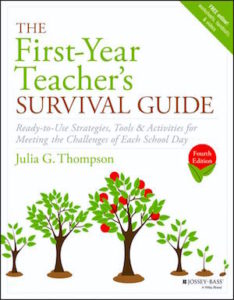The Teacher’s Challenge: Balancing Work and Life
As novice teachers work to become successful in their first years of teaching, they have so many matters to attend to. Julia Thompson, author of the seminal book The First-Year Teacher’s Survival Guide (now in its 4th edition), has her own version of a beginning teacher to-do list. Some of her top priorities might surprise you.
“Taking ownership of your professional growth” ranks first on her list of urgent new-teacher business. Other top priorities include
• developing a reflective practice;
• learning from role models and mentors;
• seeking feedback on your performance;
• using the evaluation process to improve your performance; and
• creating a professional portfolio.
All of these are certainly important (and you’ll learn why if you read her book). But perhaps the most challenging job of a first-year teacher is the matter Thompson leaves for last: maintaining a work/life balance. Here’s what she has to say about that.

Education is often ranked as one of the most stressful of all career choices. The chief cause of this ranking frequently lies in the unfortunate combination of too many pressing responsibilities and the idealistic dedication that many teachers feel about their work.
Emotionally, mentally, and physically challenging, teaching is a compelling profession where teachers find it all too easy to immerse themselves in their school duties to the detriment of their personal lives. The result is that many teachers report significant stress due to a harmful work-life imbalance.
Because being a teacher means that daily responsibilities begin early and seem never to end, it is not always easy to leave the demands of school at school. Because we are in the business of changing lives, we feel the weight of those responsibilities long after we have left the building. One of the occupational hazards all successful teachers face is that it is all too easy to take home not only our paperwork but also our worries about our school days.
Successful teachers who want a long-term career in education must learn how to juggle the demands of being in a classroom all day long and still maintaining a satisfactory personal life. The key? Finding a balance between the challenges of a new career and such personal needs as maintaining friendships, meeting family responsibilities, and pursuing other endeavors that bring fulfillment and joy to life.
To learn how to be one of those successful teachers who seem to have found the right balance between their personal and professional lives, consider putting some of these suggestions into practice:
Make time for yourself. Eat well. Exercise. Count your blessings. Plan enjoyable activities. Your students will not thrive if their teacher is exhausted and stressed. Take good care of yourself if you want to be able to focus on caring for your students.
Schedule a gym class, hobby, or something else that starts one to two hours after the school day ends, at least two days a week. It will help you prioritize what needs to get done. Staying at school too long can lead to poor time management because you feel like you have forever to accomplish things. It can also lead to burnout.— Margaret R. Scheirer, 12 years’ experience
Don’t lose sight of the big picture. No one can teach every part of the curriculum or reach every student or make every school day a success. What you can do, however, is realize that each school year is not a sprint but a marathon. It takes patience, determination, and a clear idea of the desired outcome for runners to complete a marathon; the same is true for teachers.
See the opportunities in your problems. When you have a problem at school, try to think of it as an opportunity to learn new professional skills.
Work efficiently while you are at school. Prioritize the tasks that you must accomplish and work steadily at them. Use your planning time and any spare moment to their fullest advantage. The more you accomplish at school, the less you will have to do at home, leaving you with the time you need to enjoy life away from school.
Focus on the tasks at hand. Too often teachers find it easy to second-guess their decisions or to replay troublesome scenarios from the day. Instead of endlessly rehashing what went wrong, focus on productive tasks, such as designing the plans you need to create or new activities to spark your students’ interest.
Set boundaries. No one expects you to be on call twenty-four hours a day. For example, it is not wise to give out your personal phone number. Although there will be many after-school demands on your time, learn to gently refuse those that will be too demanding or unproductive.
Keep your career worries in perspective. When something goes wrong, ask yourself if you will still be affected by it in a year, in a few months, or even in a week. Try to focus on the big picture instead of allowing nagging small issues to rob you of your peace of mind.
Always have something to look forward to. Make a point of planning a weekend excursion or an outing with family and friends or even setting aside time to work on a hobby. Looking forward to something pleasant in the future will help you maintain your equanimity in the present.
Don’t forget that your new profession is only one part of a rewarding and busy life. If you find that you are spending too much time at school or worrying about school after you have left for the day, then it’s time to take steps to manage that school- induced stress.
I try to leave the emotion of work at work. I take paperwork home, but I try not to take the emotional stuff home. My husband and I have a ten-minute rule. We can each vent about our jobs for ten minutes at dinner, then that is it. No more. Move on. Tomorrow is another day. — Mary Landis, 22 years’ experience
Stop trying to control everything. Choose your battles wisely by asking yourself if the issue that is troubling you is worth your time and energy.
Allow yourself time to make effective transitions from one class to another. This is particularly difficult when you have many classes each day. One way to manage this is by having an opening routine that your students can do independently. This will free you to make the mental, emotional, and physical switch from one group of students or from one content area to another.
Keep a flexible attitude. Get into the habit of looking for solutions instead of dwelling on your problems. If you are open to alternatives, you will be able to assess your options much more quickly.
Delegate responsibilities. Decide who you want to do a task, clearly explain how you want it accomplished, and then step back and allow the people you selected to get busy.
Stop rushing from one responsibility to the next. Slow down. Here are some ways to slow your school life down: take the time to eat lunch, allow yourself ten minutes to relax with colleagues at some point during your day, and use a journal for reflection.
Learn to pace your instruction to allow for some less intense teaching periods. You should not be “on” day after day. Instead, allow your students time for independent work, small-group work, or even such activities as viewing films related to the subject under study.
Add structure to your life. Routines will prevent many stress-inducing problems. Putting your keys in the same place every day, for example, will save you frustration later.
Reflect on the positive things that happen at school. When it comes time for that important self-reflection, be sure to think about the positive things that happen each day. Focusing on your strengths and your successes is just as important as improving weaknesses and correcting mistakes.
Think before you act. If you plan your responses to unpleasant situations, you will prevent many problems. Situations that you should think about before you act include dealing with incomplete homework assignments, angry parents, defiant students, cheating incidents, tardy students, and other frequent classroom disruptions.
Take advantage of the assistance your district may offer its employees. Many districts offer various types of mental health assistance to their employees. Often referred to as an EAP (Employee Assistance Program), this district-wide assistance can take many forms, such as counseling referrals, wellness activities, online stress reduction classes, support groups, financial coaching, help with substance abuse, and many others.
Start to put together a network of supportive and positive people who can help you. Being connected to others is an important way to avoid the stress that can make every day miserable. Supportive colleagues can help you figure out the solutions you need.
On this last point:
Even though you will probably be assigned an official mentor, you can learn a great deal from other colleagues as well. If you look around your school, you’ll find an organized teacher or two who can serve as role models when it comes to productivity. You will find someone who is masterful at dealing with upset parents or who can make even the most disruptive student remain focused and on task. Soon you will see that role models for just about every aspect of your school life are all around you if you take the time to look and learn.
Many teachers also use social media to create a PLN, or personal learning network. A PLN is simply a way for individuals to use social media to connect with other educators to collaborate, share ideas, and explore common professional interests. Many educators who want to establish a PLN start by following bloggers who post about topics they want to explore further – and then expand outward to investigate social media sites such as Twitter, Facebook, Instagram, and Pinterest.
Education Blogs to Get You Started
There are hundreds of insightful educational bloggers whose posts are not only interesting to read but also thought provoking. Subscribing to several blogs with a variety of viewpoints can help you keep up with educational trends while learning about new resources and strategies. In the following list, you will find just a few sites to begin this aspect of your professional development:
BAM Radio Network. In addition to its great selection of podcasts about teaching and learning, this site offers a variety of blogs for educators to follow. Carefully curated, the posts offer sound educational advice and insights on an enormous number of topics.
Cool Cat Teacher Blog. Vicki Davis writes on a variety of useful topics and has interesting guest posts. She often has extensive lists of online resources that appeal to teachers of all grade levels.
The Cornerstone for Teachers. At Angela Watson’s blog, readers can find useful advice about many of the challenges facing classroom teachers.
Cult of Pedagogy. Jennifer Gonzalez’s blog offers interesting, easy-to-read, practical tips about various classroom matters for all K–12 teachers. Follow her on Twitter @cultofpedagogy for PLN-building tweets.
Larry Ferlazzo. Larry Ferlazzo’s extensive offerings cover topics of interest to K–12 teachers, including a curated daily list of online articles. A prolific contributor to national publications, Ferlazzo also writes a blog for Education Week called Classroom Q&A. His comprehensive Twitter feed @larryferlazzo often focuses on one of his specialties – English Language Learners.
Smart Classroom Management. On this site, readers can easily access the many useful, easy-to-implement tips and techniques related to a positive classroom environment found in Michael Linsin’s frequent posts.
Teach Like a Champion. Author of Teach Like a Champion 2.0 and several other helpful books, Doug Lemov in his blog offers well-written insights on many topics that can help you grow as an educator. In particular, his classroom management strategies are especially helpful for first-year teachers.
________________________

Author of The First-Year Teacher’s Survival Guide (4th Edition); Discipline Survival Guide for the Secondary Teacher; First-Year Teacher’s Checklist; and The First-Year Teacher’s Survival Guide Professional Development Training Kit (summarized here), Thompson also provides advice on a variety of subjects through her website, on her blog, and on Twitter.

































Excellent advice, but not applicable to the unfortunate teacher at a charter school that can take away all planning time and give you students who won’t enter the classroom on their own without administrators yelling and won’t do their work. The reality for many first-year teachers is grim at the kind of schools that have openings.
Hi Virginia,
I can certainly sympathize with you over the grim reality that many teachers–not just first-year ones–have to cope with at a tough school whether it is a charter school or a public school. I spent most of my forty years as a teacher working in very tough schools. Daily fights, extreme disrespect, work refusal, little or no resources or planning time, and overwhelmed administrators…things that you are probably familiar with, too. I went home many nights feeling emotionally and mentally drained. But I decided that it had to be possible to work in that environment and not give in to hopelessness and stress. And I figured out how to make it work. Not every day was perfect, especially at first. But I did it. And if I could manage it, so can anyone else.
I focused on what I could do in my classroom to be positive. I learned to sit with other positive teachers at lunch (even on the days when I was tempted to be negative and vent). I worked at streamlining my procedures so that the focus was on learning and not on me yelling at students. I worked to make my classroom a haven of peace and quiet and success. I made an effort to be more positive and supportive with my students, especially the challenging ones. I worked at what I could change every day and tried to accept the rest. I know that once I decided to fight back, I felt better about school and my students and myself. And I wanted to help other teachers cope. Stay in touch if you think it would help. You are not alone in this struggle. I wish you only the best as you look to the year ahead. ~Julia